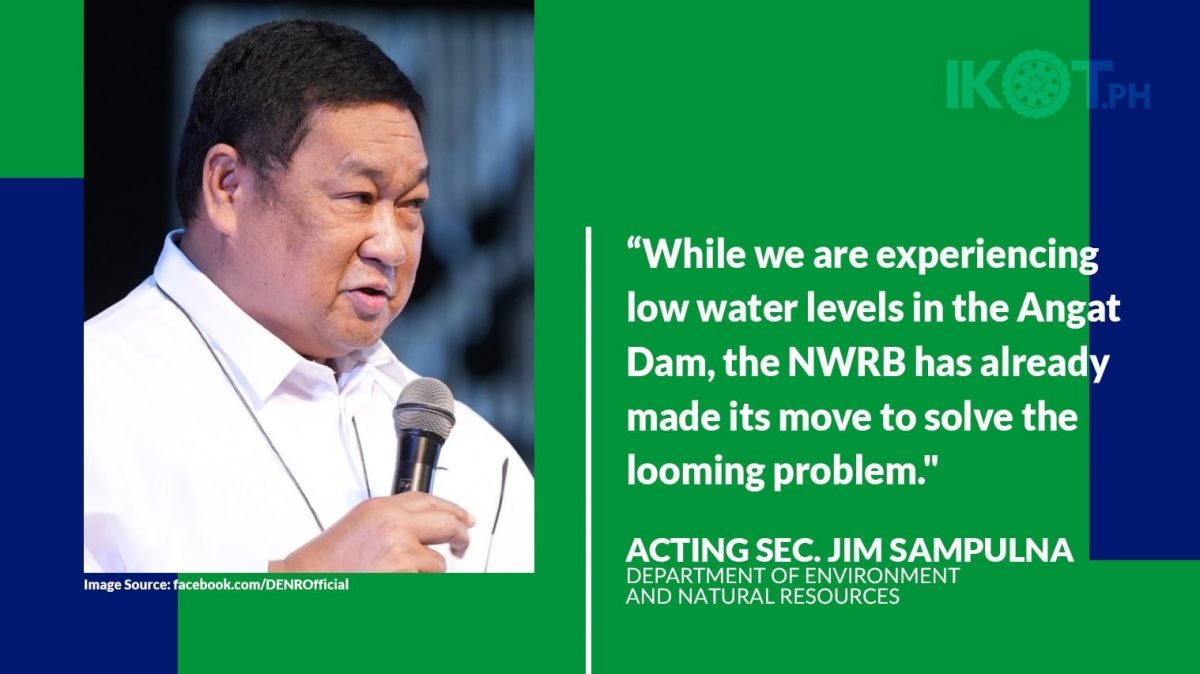Amid the decreasing water level in Angat Dam, Department of Environment and Natural Resources (DENR) Acting Secretary Jim Sampulna assured the public that the National Water Resources Board (NWRB) remains on top of the situation as it continues to undertake measures to ensure sufficient water supply during the dry season.
“The NWRB will be in the forefront of monitoring the water level of the Angat Dam and putting contingency measures in place. While we are experiencing low water levels in the Angat Dam, the NWRB has already made its move to solve the looming problem,” Sampulna said.
The NWRB is an attached agency of the DENR that is responsible for the management and regulation of all water resources and services in the country.
NWRB Executive Director Sevillo David Jr. said the agency—in coordination with the Metropolitan Waterworks and Sewerage System (MWSS), National Irrigation Administration (NIA), National Power Corporation (NPC), and Philippine Atmospheric, Geophysical and Astronomical Services Administration (PAGASA)—has been implementing mitigation strategies to address the possible inadequacy of water supply from the Angat Dam, which supplies 97 percent of Metro Manila’s water requirements.
Some of the measures include the reduction of allocation for domestic and irrigation requirements, reactivation of deep wells for the use of MWSS, cloud seeding operations, and maximizing the use of water treatment plants owned by water concessionaires Maynilad and Manila Water.
David said that the domestic water allocation of 48 cubic meters per second (cms) will be retained in March, noting that having a sufficient water supply helps control the spread of coronavirus.
Meanwhile, he pointed out that the case for the irrigation sector is different because “when the harvest is approaching, the lesser water will also be needed for the crops.” The allocation is reduced from 20 cms to 15 cms.
The NWRB is also working in coordination with NIA for the implementation of various measures for effective water management including the use of shallow tube wells to reduce the consumption of water for irrigation.
“We are using what they call shallow tube wells to enable farmers to optimize water coming from creeks and canals.”
“We are using what they call shallow tube wells to enable farmers to optimize water coming from creeks and canals,” David said.
To prevent the further decrease of water level in Angat Dam, the MWSS is also planning to conduct cloud seeding operations in March and April.
“We decided to conduct the cloud seeding operations this March due to the right weather conditions.”
“This endeavor is in coordination with the Philippine Atmospheric, Geophysical and Astronomical Services Administration. We decided to conduct the cloud seeding operations this March due to the right weather conditions and after the amihan or northeast monsoon season,” David said.
Cloud seeding operations will be conducted in different areas including the Angat Watershed and Bustos Dam in Bulacan and La Mesa Dam in Quezon City, which will be implemented from March 7 to April 10, 2022.
Meanwhile, the public is encouraged to partake in the efforts to secure the availability of water especially in the coming dry season by conserving water and using it with utmost care and efficiency.


